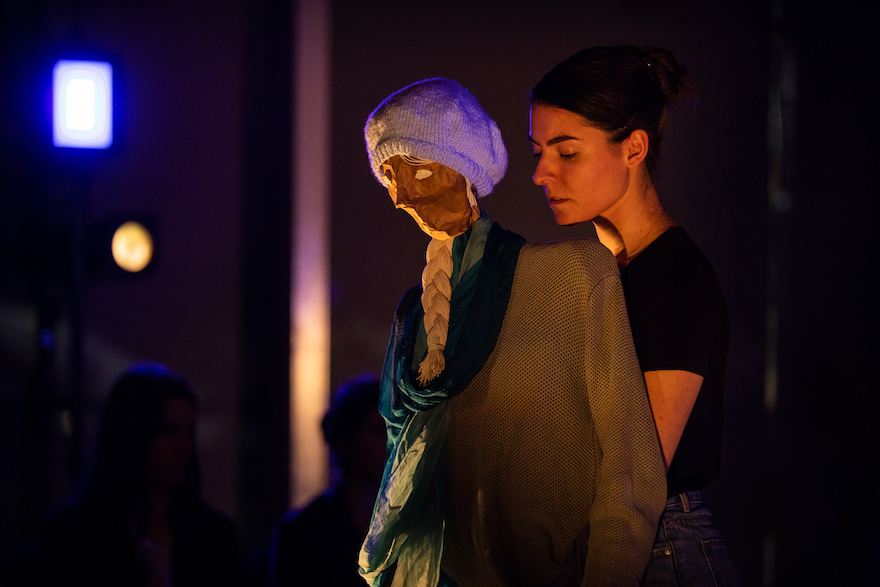WAAPA and Spare Parts Puppet Theatre have created a journey well worth taking, even if Varnya Bromilow is left with more questions than answers.
All aboard ship of fools for entertaining ride
28 October 2022
- Reading time • 7 minutesPerformance
More like this
- Unlocking a box of wonders
- Tracker evokes trails and tribulations
- Tempest takes our breath away
The Last Ship Left, WAAPA & Spare Parts Puppet Theatre •
WA Maritime Museum, 27 October 2022 •
The WA Maritime Museum’s a hell of a building, isn’t it? Waiting in the foyer Thursday night, I was struck by the cavernous beauty of the space. You really do feel like you’ve entered the belly of a ship, or maybe a whale. Which makes it the perfect venue for The Last Ship Left, a collaboration between Spare Parts Puppet Theatre and WAAPA’s 3rd year performance making students. The 50-minute show uses the space to terrific effect – at times, it felt like we were on a bizarre tour.
WAAPA’s performance makers and Spare Parts have developed a strong relationship over many years. For the makers, it’s an opportunity to showcase their skills in a professional setting, with one of Australia’s longest running puppet theatre. For Spare Parts, it’s a chance for Associate Director Michael Barlow to co-create a work that does not have to cater to little kids. The results are often experimental and proudly unorthodox – The Last Ship Left is no exception.
Even before we enter the museum, we’re – greeted is the wrong word – leered at by a couple of sullen youths, their papier mâché faces snarling and sniping at unsuspecting audience members.

Once inside, a more cordial greeting is given – this time from a couple of blonde ship stewards, whose broad accents place them somewhere around Fountain Lakes. These chummy stewards are keen to welcome us aboard the last airship, bound for Mars, leaving behind a ruined Earth.
We’re in illustrious company – the Premier (the excellent Marli Haddeill and Holland Brooks), a silver-haired bodgie in Aussie flag boardies, is also there. But the trustworthiness of the Premier is in doubt – this is a man with three different faces, that swivel cleverly about at the puppeteers’ whim.
Our two stewards shepherd us through the foyer where we’re delayed by a rousing speech from the Premier and a photo op with his son and daughter, the aforementioned surly youths. We’re promised sausage sizzles (they’ve already built a Bunnings on Mars) and lives of leisure, free from the earthly worries of a degrading planet.
The audience titters – we’re co-conspirators now – and we make our way up the sweeping stairs to the top floor. But we’re waylaid again, this time by a father and infant daughter, bidding farewell to their wife and mother who has elected to stay on Earth. In a show that has been broadly comic up until this point, it’s a strange tonal shift.

Finally, we’re about to board and as we wait, a Bard entertains us with song. There are many excellent performers in the show, but for me, the first time I completely forgot about the presence of the performer (surely a puppeteer’s primary goal?) was in Leisl Lucerne-Knight’s marvellous depiction of the Bard. With her sinuous physicality as the Bard strums and plays, the subtly expressive movements of the Bard’s head, Lucerne-Knight utterly embodies the character in a way that is joyful to witness.
At this point in the show, solid foundations have been laid. We have been introduced to several key characters and there’s a delicious sense of expectation as we board the craft.
Unfortunately, the latter half of the show trades narrative for chaos. It’s beautiful chaos – the puppets are wonderfully evocative; there are some gorgeous, pop-art-styled projections overhead; the performers are committed and energetic, frantic even. But there’s a general abandoning of the characters we had come to know.

There are tensions aboard the ship, of a mostly philosophical nature. The central argument concerns the purpose of art in our lives and the worth of different types of artistic expression. Ordinarily, I love a good debate, particularly when centred around how we humans derive meaning from life, but here it felt strangely jarring. Where were the characters we’d met? How would they survive? What happened to the Bard? With a brief, vague exception involving the mother and child, we’re given no resolution.
Quibbles aside, it was certainly an entertaining ruckus. The craggy-faced puppets, with their straggly hair and strange, pale eyes, were arresting; the WAAPA players expertly deft in their manipulations. The Last Ship Left piqued one’s curiosity, even if it provided no answers.
The final performance of The Last Ship Left is at WA Maritime Museum tonight.
Pictured top: Leisl Lucerne-Knight gives a marvellous depiction of the Bard. Photo: Stephen Heath
Like what you're reading? Support Seesaw.






